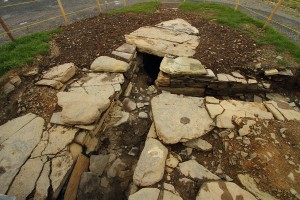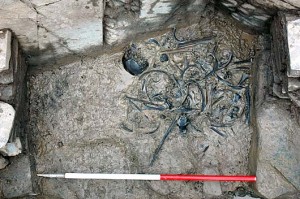 At least a thousand human bones have been found along with otter bones and feces in a 5000-year-old tomb in the Orkney Islands, an archipelago north of Scotland. Property owner Hamish Mowatt discovered the tomb last year when he broke a small hole through the capstones in the ceiling of the tomb and dropped a camera down into the opening. He saw what looked like a human skull floating in water. He reported it to the authorities and a team from the Orkney Research Centre for Archaeology (ORCA) came to excavate the site.
At least a thousand human bones have been found along with otter bones and feces in a 5000-year-old tomb in the Orkney Islands, an archipelago north of Scotland. Property owner Hamish Mowatt discovered the tomb last year when he broke a small hole through the capstones in the ceiling of the tomb and dropped a camera down into the opening. He saw what looked like a human skull floating in water. He reported it to the authorities and a team from the Orkney Research Centre for Archaeology (ORCA) came to excavate the site.
In the initial excavation last fall, archaeologists found that the tomb was composed of five chambers that had been built into a rock outcropping by Stone Age inhabitants. Although there was some damage done by modern construction work, the tomb was intact, several of the chambers still sealed. This made the ORCA team happy because it’s been 30 years since an intact tomb was found, so this might be their first chance to recover human remains that would allow the use of modern techniques like isotope analysis and DNA testing to learn more about Orkey’s Neolithic people. They were able to recover the remains of eight people.
 Hard rain and wind coupled with a shifting water depth in the tomb kept the initial exploration to a short two weeks, so archaeologists returned this April. That when they found that the bones numbered at least a thousand, possibly twice that many, and belonged to a mixed group of woman, men, children, even babies. They appear to have been buried over the course of many generations, with layers of silt interspersed suggesting there were periods when it was not in use, perhaps due to flooding.
Hard rain and wind coupled with a shifting water depth in the tomb kept the initial exploration to a short two weeks, so archaeologists returned this April. That when they found that the bones numbered at least a thousand, possibly twice that many, and belonged to a mixed group of woman, men, children, even babies. They appear to have been buried over the course of many generations, with layers of silt interspersed suggesting there were periods when it was not in use, perhaps due to flooding.
They also found that layered between the human bones were the skeletal and fecal remains of otters. The tomb, officially called the Banks Tomb, was thus dubbed the Tomb of the Otters, as a companion to a well-known Neolithic tomb nearby called the Tomb of the Eagles. The otters were either using the tomb as their own disposal unit since it was built, or the otter remains were deliberately placed there over the years for ceremonial reasons unknown to us.
So far the excavations, led by the Orkney Research Centre for Archaeology, have “barely scratched the surface,” [Julie Gibson, county archaeologist for Orkney,] added. The archaeologist is confident that the site will yield important new clues to Neolithic funerary practices.
For instance, researchers hope that DNA and isotopic analysis of the human bones will reveal if the dead were closely related and came from the same tight-knit island community or if the burials include newcomers from overseas.
Archaeologists will also investigate whether bones were removed from the tomb for ritualistic purposes.
“This burial is absolutely packed with remains, but with most [other Stone Age tombs], there are actually not that many people in them at the end,” Gibson noted.
Time remains a factor. The anaerobic waterlogged conditions have kept the remains from deteriorating thus far, but there’s concern that if the water table drops due to the excavation or to external conditions, the remains will be exposed to oxygen and decay before they can be recovered.
You can behold the glamorous profession of archaeology in all its raw beauty in this fantastic YouTube playlist of dispatches from the last fall’s excavation. They’re all brief, but they do a great job of presenting archaeological methods and discoveries in daily increments. When you’re done with season one, here’s the second dig season.